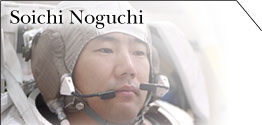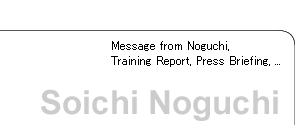Astronaut Noguchi's Training Report, #5
ISS Extravehicular activity
Last Updated: July 29, 2003
 |
 |
| Astronaut Stephen Robinson (left) and astronaut Souichi Noguchi (right) |
Astronaut Noguchi during EVA training |
Extravehicular activity (EVA) is scheduled three times during the 13-day STS-114 mission. The crew will enter space from the Quest Airlock to work six to seven hours at a time. We usually perform EVA in pairs. I will pair with Mission Specialist Stephen Robinson for the STS-114 EVA.
STS-114 EVA tasks
We have many EVA tasks in the STS-114 mission. I will show you several of them.
We will install the External Storage Platform 2 (ESP2) as part of the International Space Station (ISS) assembly sequence. The ESP2 will be installed between the Quest Airlock and the US laboratory Destiny to provide on-orbit temporary stowage for future assembly work.
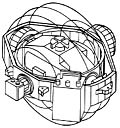 |
| CMG |
We will replace failed ISS components, such as the Control Moment Gyro (CMG) that provides attitude control.
We will also install a science experiment. In this experiment, various materials and equipment will be exposed to space to study the effects of the space environment. Experiment samples will be returned to scientists on the ground.
EVA training facility
 |
| NBL |
 |
Where do astronauts train for EVA? The answer is "in water." In water, we can practice EVA tasks in simulated weightlessness similar to that in space due to the buoyancy of water. For EVA training in water, NASA has a huge pool where astronauts train almost every day. The pool is called the Neutral Buoyancy Laboratory (NBL) and is as large as a football field. Its depth is 12m, and ISS mockups rest on its bottom. Many divers work in NBL to support astronauts in training and to prepare mockups for training. They begin preparation for training before astronauts get to NBL at 7:00 a.m.
Difficulties in EVA -training tips
The difficult part of EVA is that it takes a long time, six to seven hours at a time. We have to wear stiff spacesuits and can't take meals or rest for more than ten hours, including the preparation period. In weightlessness, we have to move by holding grab handrails or tethers. Most EVA tasks require fastening bolts, connecting electrical connectors, and transferring components, so great physical strength and endurance are needed in order to accomplish EVA tasks.
 |
| EVA with various tools (STS-101 mission) |
EVA crew members use almost 100 kinds of tools in the standard six- hour training. We should use those tools properly and also identify them by their proper names to coordinate with people on the ground.
It is important for us to understand the spacesuit components. The spacesuit consists of complex systems, a power-control unit, a life- support system, a communication system, and an emergency life-support system. It is thus like a one-seat space ship. In space, we must deal with problems in the spacesuit such as air leaks and electrical shorts.
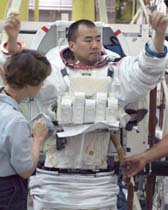 |
| Getting into EMU Commander Eileen Collins as IV (left) |
 |
| Astronaut Wakata operating Remote Manipulator system |
The astronaut inside the space shuttle during EVA is called the Inner Vehicle crew member, IV, who plays an important role in the EVA by confirming that the EVA is proceeding properly and safely. Good communications between EVA members and the IV member is critical to execute EVA tasks satisfactorily. For the STS-114 mission, Commander Eileen Collins serves as the IV member. I serve as the prime EVA member, called EV1, and will wear the spacesuit with red lines in order for the IV to distinguish EV1 from EV2. In our EVA mission, IV must coordinate EV1, EV2, and the astronaut who will operate the ISS manipulator system.
During the EVA, we will install various components including a long stanchion (more than 1m) and a large component heavier than 500kg in various places. We need to take every care not to damage the ISS or these components.
Veteran astronauts' advice
While I receive EVA training, I feel that EVA requires expert workmanship. In a procedure like "Turn on a switch at panel A of the payload," anybody would conduct it in almost the same way. However, we can't perform tasks the same way for EVA procedures like "Unfasten bolt A on truss B." Each astronaut conducts the task in different ways, depending on his or her constitution, physical capacity, and skill. There are many ways to get to the work place, employ tools, and fix the body to the ISS. Thus, astronauts try to seek better ways all the time during EVA training and to eliminate unnecessary motions.
As I have shown you, EVA procedures are not simple, so people discuss EVA procedures frequently. STS-114 crew members also confirm the EVA procedures for hours before EVA training in the NBL, and hold debriefings after the training to discuss the result thoroughly. Advice of experienced EVA astronauts is very helpful. I don't know why, but many veteran EVA astronauts talk philosophically. Their talks on EVA are very interesting, as if they were talking about their philosophies of life. I will introduce some of them that strongly impressed me.
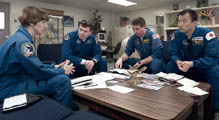 |
| Meeting |
"Slower is faster."
The more slowly and certainly you perform EVA tasks, the faster you accomplish them in the end. This slogan also literally warns us to move slowly because we might make a mistake by moving much faster in weightlessness with no air resistance.
"Train like you fly."
This slogan is similar to "practice as on orbit, on orbit as practice." It is not just a mental doctrine. It means we should make positive efforts to make training environments as close as possible what we will experience in space, and we should train under conditions as near to those in the actual on-orbit environment as possible.
"Always think you're in space."
During EVA training, we should imagine floating at an altitude of 400km instead of at the bottom of a pool with a depth of 12m. Though it is easy to say, it is difficult to carry out. I think that it is hard to visualize space with divers and air bubbles unless one has experienced space flight.
"EVA is an art."
This slogan may mean that EVA requires craftsmanship. We will need both procedures on paper and techniques depending on the knowledge, skills, and creativity of individuals to complete EVA.
You may think the spacewalk to be elegant, but I hope you know that the spacewalk is backed by professional skills. Please pay attention to the activities of the "space carpenters" in the future.
